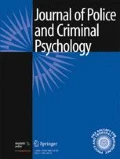Abstract
Incidents of mass murder have gained considerable media attention, but are not well understood in behavioral sciences. Current definitions are weak, and may include politically or ideological motivated phenomenon. Our current understanding of the phenomenon indicates these incidents are not peculiar to only western cultures, and appear to be increasing. Methods most prominently used include firearms by males who have experienced challenging setbacks in important social, familial and vocational domains. There often appears to be important autogenic components (Mullen Behavioral Sciences and the Law (22)3, 2004), including dysthymic reactions and similar antecedents. There have been observations of possible seasonal variations in mass murders, but research to date is inadequate to establish this relationship. It is recommended behavioral sciences and mental health researchers increase research efforts on understanding mass killings, as the current socioeconomic climate may increase vulnerability to this phenomenon, and the incidents are not well understood despite their notoriety.
Similar content being viewed by others
References
Aitken L, Oosthuizen P, Emsley R, Seedat S (2008) Mass murders: implications for mental health professionals. Int J Psychiatry Med 38(3):261–269
Alvis-Banks D (2007) Panic, chaos grip campus. The Roanoke Times, p. 2. Retrieved June 23, 2009, from Access World News database. April 17
Dietz P (1986) Mass, serial and sensational homicides. Bull NY Acad Med 62:477–491
Duwe G (2004) The patterns and prevalence of mass murder in twentieth century America. Justice Q 21(4):729–761(33)
Duwe G (2005) A circle of distortion: the social construction of mass murder in the United States. West Crim Rev 6:59–78
Europe Intelligence Wire (2002) New school tragedy as 18 killed. The Express. Retrieved June 25, 2009 from the Access World News database. April 27
Fox JA, Levin J (2003) Mass murder: an analysis of extreme violence. J Appl Psychoanal Stud 5:47–64
Fox JA, Levin J (2005) Extreme killing: understanding serial and mass murder. Sage, Thousand Oaks, pp 153–253
Harper D, Voigt L (2007) Homicide followed by suicide. Homicide Stud 11(4):295–318
Hempel A, Melroy J, Richards T (1999) Offender and offense characteristics of a nonrandom sample of mass murderers. J Am Acad Psychiatry Law 27:213–225
Holmes RM, Holmes ST (1998) Serial murder, 2nd edn. Sage, Thousand Oaks
Lackmeyer S, Zizzo D (1995) Morning of terror: city struggles with sock of deadly bombing-scores killed in bomb blast; state stunned. The Daily Oklahoman, p1. Retrieved June 23, 2009 from the Access World News database. April 20
Levin J, Fox JA (1996) A psycho-social analysis of mass murder. In: O’Reilly-Fleming T (ed) Serial & mass murder: theory, research, and policy. Canadian Scholars’ Press, Toronto, pp 55–76
Levin J, Madfis E (2009) Mass murder at school and cumulative strain: A sequential model. Am Behav Sci 52(9):1227–1245
Madigan M (2008) Mining camp massacre. Rocky Mountain News, p. 35NEWS. Retrieved June 23, 2009 from the Access World News database. December 23
Mullen PE (2004) The autogenic (self-generated) massacre. Behav Sci Law 22(3):311–323
Obmascik M (1999) High school massacre: Columbine bloodbath leaves up to 25 dead. The Denver Post, pp. A-01. Retrieved June 23, 2009, from Access World News database. April 21
Ostrow RJ, MacCormack Z (1993) A tragic end: FBI hoped to drive members to surrender with daily doses of gas. Austin American-Statesman, p A1. Retrieved on June 23, 2009 from the Access World News database. April 20
Palermo GB (1997) The berserk syndrome: a review of mass murder. Aggress Violent Behav 2:1–8
Palermo GB (2007) Homicidal syndromes: a clinical psychiatric perspective. In: Kocsis RN (ed) Criminal profiling: International theory, research, and practice. Humana Press, Totowa, NJ, pp 3–26
Petee TA, Padgett KG, York TS (1997) Debunking the stereotype: an examination of mass murder in public places. Homicide Stud 1(4):317–337
Simpson L, Bronwen H (1996) Sunday slaughter—Australia’s worst mass murder: Up to 40 dead in gunman’s bloody rampage. The Sydney Morning Herald, pp 1. Retrieved June 23, 2009, from Access World News database. April 29
Smith L (2009) 13 dead in Azerbaijan State Oil Academy shooting. College News. Retrieved June 25, 2009 from http://www.collegenews.com/index.php?/article/twentysix_people_shot_at_azerbaijan_state_oil_academy_04302009281815715/. April 30
Author information
Authors and Affiliations
Corresponding author
Rights and permissions
About this article
Cite this article
Bowers, T.G., Holmes, E.S. & Rhom, A. The Nature of Mass Murder and Autogenic Massacre. J Police Crim Psych 25, 59–66 (2010). https://doi.org/10.1007/s11896-009-9059-6
Published:
Issue Date:
DOI: https://doi.org/10.1007/s11896-009-9059-6



